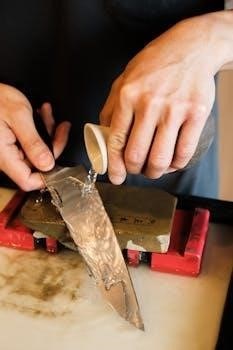
Whetstone Angle Guide⁚ A Comprehensive Guide
Sharpening knives with whetstones can be challenging, especially for beginners. This guide explores how whetstone angle guides simplify the process, ensuring consistent and precise sharpening. Discover how these tools help achieve a perfect edge every time.
Whetstone sharpening is a traditional method for achieving razor-sharp edges on knives and tools. It requires maintaining a consistent angle between the blade and the stone. For beginners, achieving and maintaining this angle can be difficult. This is where whetstone angle guides come in. These guides are designed to help users maintain the correct angle throughout the sharpening process. They help to eliminate guesswork and ensure a consistent, sharp edge. They are available in various designs and materials to suit different blades and preferences. These guides make whetstone sharpening accessible to everyone.
Understanding the Importance of Angle in Whetstone Sharpening
Maintaining a consistent angle is crucial for effective whetstone sharpening. The angle directly impacts the edge’s sharpness and durability. Understanding this relationship is key to achieving optimal results.
Why Consistent Angle Matters for Edge Quality
Maintaining a consistent angle during whetstone sharpening is paramount for edge quality. Varying the angle leads to uneven sharpening, creating a weak, inconsistent edge. A precise angle ensures the blade’s edge is uniformly ground, resulting in optimal sharpness and longevity. Consistent sharpening preserves the blade’s intended geometry. This consistent approach extends the life of the knife. Using an angle guide simplifies maintaining accuracy, especially for beginners.
Types of Whetstone Angle Guides
Whetstone angle guides come in various forms, each offering different benefits. Options include clip-on guides, magnetic guides, and digital angle finders, each designed to assist in maintaining a consistent sharpening angle.
Clip-on Guides⁚ Functionality and Blade Compatibility
Clip-on angle guides attach to the spine of the knife, aiding in maintaining a consistent sharpening angle. These guides often feature ceramic or plastic contact points to prevent blade scratches. Ensure the guide’s width compatibility matches your knife’s blade for effective use. Many are designed for blades between 3.5cm and 5cm wide, targeting a 16-degree angle, ideal for Japanese knives. They are user-friendly, making them suitable for beginners learning whetstone sharpening.
Magnetic Angle Guides⁚ Precision and Ease of Use
Magnetic angle guides offer a secure attachment to the knife blade, enhancing stability during sharpening. Their strong magnetic grip minimizes slippage, promoting consistent angles. These guides are known for their ease of use, particularly for those seeking a reliable and repeatable sharpening process. While offering precision, users should ensure the magnet’s strength is appropriate for the blade to avoid any potential magnetization. Magnetic guides are a step up, offering precision and ease in maintaining the correct angle.
Digital Angle Finders⁚ Achieving Exact Angles
Digital angle finders provide the highest level of precision in whetstone sharpening. These devices measure the exact angle of the blade relative to the whetstone, displayed on a digital screen. This allows users to maintain a consistent and accurate angle throughout the sharpening process. While offering unparalleled accuracy, digital angle finders may require a learning curve and careful calibration. They are ideal for users who demand precise and repeatable results, ensuring optimal sharpness for their knives.

Using Whetstone Angle Guides⁚ A Step-by-Step Guide
This section provides a detailed, step-by-step guide on effectively using whetstone angle guides. Follow these instructions to ensure optimal sharpening results and maintain the perfect edge on your knives.
Preparing the Whetstone and Knife
Before using an angle guide, proper preparation is crucial. Start by soaking your whetstone in water or applying honing oil, depending on the stone type. Ensure the stone is stable on a non-slip surface. Clean the knife blade thoroughly to remove any debris or grease. A clean blade and properly prepared whetstone will ensure smooth and effective sharpening with the angle guide, leading to a sharper and more consistent edge.
Attaching and Positioning the Angle Guide
Attaching the angle guide correctly is vital for achieving the desired edge. Clip-on guides should be securely fastened to the spine of the knife blade, ensuring they are snug and don’t slip during sharpening. Magnetic guides should be firmly attached to the blade’s side, maintaining a consistent distance from the edge. Proper positioning ensures the guide maintains the correct angle, leading to even sharpening and a professional-quality edge.
Maintaining the Correct Angle During Sharpening
Maintaining the correct angle throughout the sharpening process is paramount. Apply consistent pressure while keeping the angle guide flush against the whetstone. Avoid wavering or lifting the knife, as this can lead to an uneven edge. Focus on smooth, controlled strokes, ensuring the guide glides effortlessly. Regularly check the angle guide’s position to confirm it remains stable and properly aligned, ensuring optimal sharpening results.

Angle Recommendations for Different Knife Types
Different knives require specific sharpening angles for optimal performance and durability. Selecting the correct angle is crucial for maintaining the integrity and functionality of each blade type, from kitchen knives to pocket knives.
Kitchen Knives⁚ Aiming for 15-20 Degrees
For kitchen knives, a sharpening angle between 15 and 20 degrees is generally recommended. This range provides a balance between sharpness and durability, ideal for the varied tasks performed in a kitchen. A shallower angle, closer to 15 degrees, offers exceptional sharpness for slicing and delicate work. However, it can make the edge more prone to damage. A slightly steeper angle, near 20 degrees, provides a more robust edge that can withstand heavier use and chopping. Using an angle guide ensures consistency.
Pocket Knives and Utility Blades⁚ 20-25 Degrees
Pocket knives and utility blades, often subjected to tougher tasks than kitchen knives, benefit from a slightly wider angle of 20-25 degrees. This increased angle provides enhanced durability and resistance to chipping, essential for knives used on various materials and in more demanding situations. The greater angle sacrifices a bit of the fine sharpness found in kitchen knives, but that is more than compensated for by the edge’s ability to withstand heavy use. Utilizing an angle guide is important for maintaining a uniform edge when sharpening these blades.
Benefits of Using an Angle Guide
Angle guides provide many advantages, especially for beginners. They ensure consistent sharpness by maintaining the correct sharpening angle. They also prevent blade damage and simplify whetstone use, making sharpening easier for everyone.
Achieving Consistent Sharpness
Maintaining a consistent angle is crucial for achieving a uniformly sharp edge. Whetstone angle guides eliminate the guesswork, holding the blade at the correct angle throughout the sharpening process. This consistency ensures that each part of the blade receives equal attention, resulting in a sharper, more reliable cutting edge. With an angle guide, even beginners can achieve professional-level sharpness, enhancing their knife’s performance and longevity. This consistent angle also reduces the risk of creating uneven bevels or dull spots on the blade.
Preventing Damage to the Blade
Using a whetstone without a guide can lead to inconsistent angles, causing damage to the blade’s edge. Applying too much pressure or varying the angle can create unwanted bevels or rounded edges, reducing the knife’s cutting efficiency. Whetstone angle guides help prevent these issues by maintaining a consistent angle, ensuring that the blade is sharpened evenly and safely. This precise control minimizes the risk of accidental damage, prolonging the life of your knives and preserving their original profile. Correct angle prevents removing too much material.
Simplifying the Sharpening Process for Beginners
For beginners, mastering the art of whetstone sharpening can be daunting due to the need for consistent angle control. Whetstone angle guides eliminate this complexity by providing a stable reference point, allowing novices to focus on technique rather than angle maintenance. By attaching the guide to the knife’s spine, beginners can easily achieve the correct sharpening angle, reducing the learning curve and minimizing errors. This simplifies the process, making it more accessible and ensuring that even those with no prior experience can achieve sharp, professional-quality results quickly and safely.
Considerations When Choosing an Angle Guide
Selecting the right angle guide involves assessing blade width compatibility, the guide’s material and durability, and adjustability for various angles. These factors ensure effective and lasting performance during knife sharpening.
Blade Width Compatibility
Ensuring your angle guide is compatible with your knives’ blade widths is crucial for effective sharpening. Guides are often designed for specific blade widths, typically ranging from narrow to wider sizes. Using a guide that doesn’t fit properly can lead to inconsistent angles or even damage to the blade. Check product specifications to match your knives with the appropriate guide size. Guides are often designed for blades of 3.5-5cm (1.4-2.0).
Material and Durability of the Guide
The material and durability of a whetstone angle guide are key factors in its longevity and performance. Look for guides made from robust materials such as steel or high-quality, durable plastics. A well-constructed guide will withstand repeated use and resist wear and tear from the whetstone. Consider the guide’s construction to ensure it provides stability and maintains its shape over time, contributing to consistent sharpening results.
Adjustability and Angle Options
Adjustability and angle options are vital for versatile knife sharpening. An ideal angle guide should offer a range of preset angles to accommodate various knife types, from kitchen knives to pocket knives. Some advanced guides even allow for fine-tuning within one-degree increments. Ensure the adjustment mechanism is secure and easy to use, maintaining the selected angle during sharpening. This adaptability ensures optimal edge geometry for different blade applications, enhancing both cutting performance and edge retention.

Maintaining Your Angle Guide
Proper maintenance of your angle guide ensures longevity and accuracy. Regular cleaning and careful storage will prevent damage and maintain optimal performance. These simple steps will keep your guide in top condition.
Cleaning and Storage Tips
To ensure your whetstone angle guide remains in excellent condition, regular cleaning is essential. After each use, wipe the guide with a damp cloth to remove any metal filings or abrasive residue. For stubborn buildup, a mild detergent can be used, followed by thorough rinsing and drying. Store the guide in a dry environment, away from direct sunlight and extreme temperatures, to prevent warping or corrosion. Consider using a protective case or pouch to shield it from dust and potential impacts, prolonging its lifespan and maintaining its accuracy.
Troubleshooting Common Issues
Encountering problems with your whetstone angle guide? This section addresses common issues like slipping and uneven sharpening. Learn how to diagnose and resolve these problems for optimal sharpening performance and consistent results.
Angle Guide Slipping
If your angle guide slips during sharpening, it can compromise the angle consistency and overall sharpness. Ensure the blade and guide are dry and free from oil. A secure grip is essential, and consider using a non-slip mat under the whetstone. Inspect the guide for wear or damage; replace if necessary. Applying excessive pressure can also cause slipping, so maintain a light, steady hand. Experimenting with different pressure levels could improve the grip.
Uneven Sharpening
Uneven sharpening can occur if pressure isn’t applied consistently across the blade. Regularly check the knife’s edge for uniformity. Ensure the angle guide is properly aligned and contacting the whetstone evenly. It is important to avoid rocking the knife during sharpening, which can alter the angle. Address any burr formation uniformly on both sides. If one section is sharper, lighten the pressure on that area. Examine the whetstone surface for irregularities.

Alternatives to Angle Guides
While angle guides offer precision, freehand sharpening is an alternative. Mastering freehand techniques requires practice. It allows for greater control and adaptability. Visual cues and muscle memory become crucial for maintaining consistent angles.
Freehand Sharpening Techniques
Freehand sharpening, an alternative to angle guides, demands skill and practice. It involves maintaining the correct angle solely through visual and tactile feedback. Begin by visualizing the desired angle, typically between 15 and 20 degrees for kitchen knives. Consistent practice builds muscle memory, enabling you to maintain the angle throughout each stroke. This technique offers greater flexibility but requires dedication to master. It’s a rewarding skill for those seeking ultimate control over their sharpening process and keen to avoid the use of tools.
In conclusion, whetstone angle guides are invaluable tools for achieving a consistently sharp edge on your knives. They simplify the sharpening process, making it accessible to beginners while enhancing precision for experienced users. By maintaining the correct angle, these guides prevent blade damage and ensure optimal sharpness. Whether you choose a clip-on, magnetic, or digital guide, the result is a perfectly honed blade ready for any task. Embracing these tools elevates your sharpening skills and ensures your knives always perform at their best.